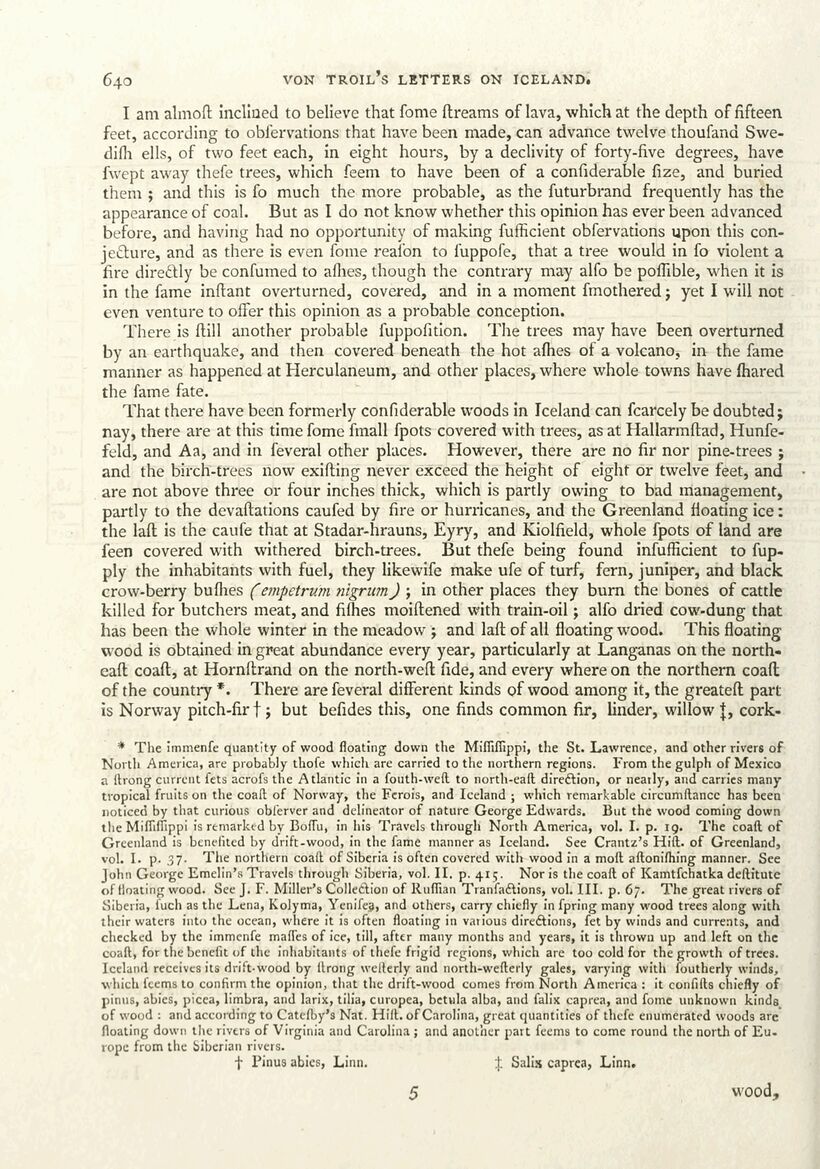
Full resolution (JPEG) - On this page / på denna sida - Pages ...

<< prev. page << föreg. sida << >> nästa sida >> next page >>
Below is the raw OCR text
from the above scanned image.
Do you see an error? Proofread the page now!
Här nedan syns maskintolkade texten från faksimilbilden ovan.
Ser du något fel? Korrekturläs sidan nu!
This page has never been proofread. / Denna sida har aldrig korrekturlästs.
640 VON TROIL’S LETTERS ON ICELAND,
I am almoft inclined to believe that fome ftreams of lava, which at the depth of fifteen
feet, according to obfervations that have been made, can advance twelve thoufand Swe-
difh ells, of two feet each, in eight hours, by a declivity of forty-five degrees, have
fwept away thefe trees, which feem to have been of a confiderable fize, and buried
them; and this is fo much the more probable, as the futurbrand frequently has the
appearance of coal. But as I do not know whether this opinion has ever been advanced
before, and having had no opportunity of making fufficient obfervations upon this con-
jecture, and as there is even fome reafon to fuppofe, that a tree would in fo violent a
fire direétly be confumed to afhes, though the contrary may alfo be poffible, when it is
in the fame inftant overturned, covered, and in a moment {mothered; yet I will not
even venture to offer this opinion as a probable conception.
There is fill another probable fuppofition. ‘The trees may have been overturned
by an earthquake, and then covered beneath the hot afhes of a volcano, in the fame
manner as happened at Herculaneum, and other places, where whole towns have fhared
the fame fate.
That there have been formerly confiderable woods in Iceland can {carcely be doubted;
nay, there are at this time fome fmall fpots covered with trees, as at Hallarmftad, Hunfe-
feld, and Aa, and in feveral other places. However, there are no fir nor pine-trees ;
and the birch-trees now exifting never exceed the height of eight or twelve feet, and
are not above three or four inches thick, which is partly owing to bad management,
partly to the devaftations caufed by fire or hurricanes, and the Greenland floating ice :
the laft is the caufe that at Stadar-hrauns, Eyry, and Kiolfield, whole {pots of land are
feen covered with withered birch-trees. But thefe being found infufficient to fup-
ply the inhabitants with fuel, they likewife make ule of turf, fern, juniper, and black
crow-berry bufhes (empetrum nigrum) ; in other places they burn the bones of cattle
killed for butchers meat, and fifhes moiftened with train-oil ; alfo dried cow-dung that
has been the whole winter in the meadow ; and laft of all floating wood. This floating
wood is obtained in great abundance every year, particularly at Langanas on the north-
eaft coaft, at Hornftrand on the north-weft fide, and every where on the northern coaft
of the country *. There are feveral different kinds of wood among it, the greateft part
is Norway pitch-firt; but befides this, one finds common fir, linder, willow {, cork-
* The immenfe quantity of wood floating down the Miffiffippi, the St. Lawrence, and other rivers of
North America, are probably thofe which are carried to the northern regions. From the gulph of Mexico
a ftrong current fets acrofs the Atlantic in a fouth-weft to north-eaft direétion, or nearly, and carries many
tropical fruits on the coaft of Norway, the Ferois, and Iceland ; which remarkable circumftance has been
noticed by that curious obferver and delineator of nature George Edwards. But the wood coming down
the Miffiflippi is remarked by Boffu, in his Travels through) North America, vol. I. p. 19. The coaft of
Greenland is benefited by drift-wood, in the fame manner as Iceland. See Crantz’s Hitt. of Greenland,
vol. I. p. 37- The northern coaft of Siberia is often covered with wood in a moft aftonifhing manner. See
John George Emelin’s Travels through Siberia, vol. II. p. 415. Noris the coaft of Kamtfchatka deftitute
of floating wood. See J. F. Miller’s Collection of Ruffian TranfaGtions, vol. III. p.67. The great rivers of
Siberia, fuch as the Lena, Kolyma, Yenifeg, and others, carry chiefly in {pring many wood trees along with
their waters into the ocean, where it is often floating in various dire€tions, fet by winds and currents, and
checked by the immenfe maffes of ice, till, after many months and years, it is thrown up and left on the
coaft, for the benefit of the inhabitants of thefe frigid regions, which are too cold for the growth of trees.
Iceland receives its drift-wood by {trong welterly and north-wefterly gales, varying with foutherly winds,
which feems to confirm the opinion, that the drift-wood comes from North America: it confifts chiefly of
pinus, abies, picea, limbra, and larix, tilia, curopea, betula alba, and falix caprea, and fome unknown kinds.
of wood : and according to Catefby’s Nat. Hift. of Carolina, great quantities of thefe enumerated woods are
floating down the rivers of Virginia and Carolina; and another part feems to come round the north of Eu-
rope from the Siberian rivers.
+ Pinus abies, Linn. { Salis caprea, Linn.
5 wood,
<< prev. page << föreg. sida << >> nästa sida >> next page >>